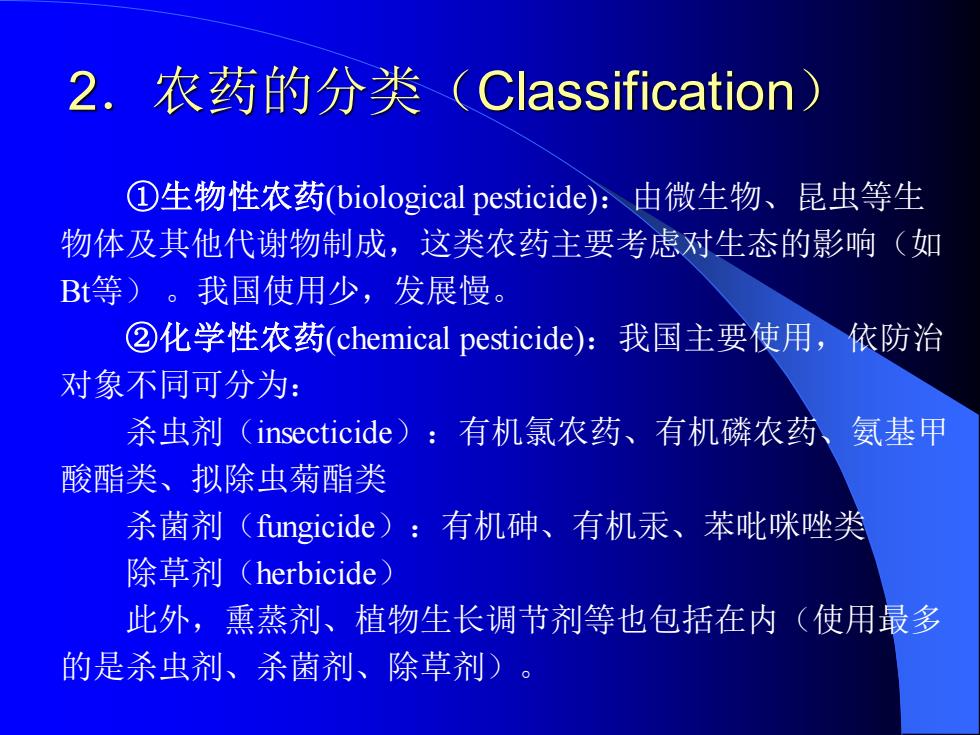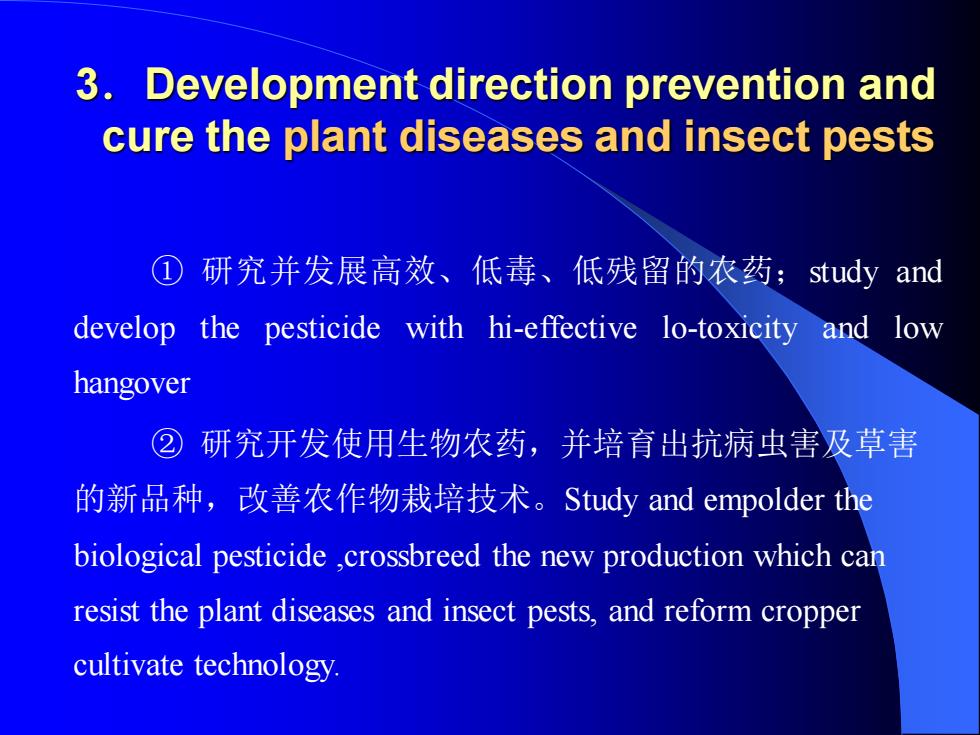
第二节 化学性污染及其预防 一、农药残留(pesticide residue) (一) 概述(perface) 1、相关定义(definition) 农药:系指用于预防、消灭或控制危害农业、 林业的病、虫、草和其他有害生物以及有目的的调 节植物、昆虫生长的化学成分或来源于生物、其他 天然物质的一种或几种物质的混合物及其制剂(农 药管理条例) 农药残留:由于使用农药会造成对环境的污染 和对食品的污染,故称之为环境农药残留或食品农 药残留
第二节 化学性污染及其预防 一、农药残留(pesticide residue) (一) 概述(perface) 1、相关定义(definition) 农药:系指用于预防、消灭或控制危害农业、 林业的病、虫、草和其他有害生物以及有目的的调 节植物、昆虫生长的化学成分或来源于生物、其他 天然物质的一种或几种物质的混合物及其制剂(农 药管理条例) 农药残留:由于使用农药会造成对环境的污染 和对食品的污染,故称之为环境农药残留或食品农 药残留

2.农药的分类(Classification) ①生物性农药(biological pesticide):由微生物、昆虫等生 物体及其他代谢物制成,这类农药主要考虑对生态的影响(如 Bt等) 。我国使用少,发展慢。 ②化学性农药(chemical pesticide):我国主要使用,依防治 对象不同可分为: 杀虫剂(insecticide):有机氯农药、有机磷农药、氨基甲 酸酯类、拟除虫菊酯类 杀菌剂(fungicide):有机砷、有机汞、苯吡咪唑类 除草剂(herbicide) 此外,熏蒸剂、植物生长调节剂等也包括在内(使用最多 的是杀虫剂、杀菌剂、除草剂)
2.农药的分类(Classification) ①生物性农药(biological pesticide):由微生物、昆虫等生 物体及其他代谢物制成,这类农药主要考虑对生态的影响(如 Bt等) 。我国使用少,发展慢。 ②化学性农药(chemical pesticide):我国主要使用,依防治 对象不同可分为: 杀虫剂(insecticide):有机氯农药、有机磷农药、氨基甲 酸酯类、拟除虫菊酯类 杀菌剂(fungicide):有机砷、有机汞、苯吡咪唑类 除草剂(herbicide) 此外,熏蒸剂、植物生长调节剂等也包括在内(使用最多 的是杀虫剂、杀菌剂、除草剂)

3.advantages and disadvantages of pesticide using ① 对农业:防治病虫害,增产丰收 it will prevent and cure insect pest and reduce damnifing to use pesticide, and it will increase production and economic benefit to take advantage to agriculture. ② 控制人畜共患传染病:controlling zoonosis ③ 对环境和食品造成污染,引起对人类健康的危害,如: 急性中毒、慢性中毒以及致癌、致畸、致突变等,并可以恶 化环境,影响生态平衡。 it will empoison environment and foods to harm human health like as acute toxicosis, chronic toxicosis, and so on. it also can depravation environment and affect environment balance
3.advantages and disadvantages of pesticide using ① 对农业:防治病虫害,增产丰收 it will prevent and cure insect pest and reduce damnifing to use pesticide, and it will increase production and economic benefit to take advantage to agriculture. ② 控制人畜共患传染病:controlling zoonosis ③ 对环境和食品造成污染,引起对人类健康的危害,如: 急性中毒、慢性中毒以及致癌、致畸、致突变等,并可以恶 化环境,影响生态平衡。 it will empoison environment and foods to harm human health like as acute toxicosis, chronic toxicosis, and so on. it also can depravation environment and affect environment balance

3.Development direction prevention and cure the plant diseases and insect pests ① 研究并发展高效、低毒、低残留的农药;study and develop the pesticide with hi-effective lo-toxicity and low hangover ② 研究开发使用生物农药,并培育出抗病虫害及草害 的新品种,改善农作物栽培技术。Study and empolder the biological pesticide ,crossbreed the new production which can resist the plant diseases and insect pests, and reform cropper cultivate technology
3.Development direction prevention and cure the plant diseases and insect pests ① 研究并发展高效、低毒、低残留的农药;study and develop the pesticide with hi-effective lo-toxicity and low hangover ② 研究开发使用生物农药,并培育出抗病虫害及草害 的新品种,改善农作物栽培技术。Study and empolder the biological pesticide ,crossbreed the new production which can resist the plant diseases and insect pests, and reform cropper cultivate technology

(二)The source of the pesticide residue in food 1.施用农药对农作物的直接污染:direct contamination of using pesticide 2.农作物从污染的环境中吸收农药croppers absorb the pesticides from contaminative circumstance. ① 喷洒的农药40-60%降落在地面污染土壤,集中在耕 作层,由植物的根部吸收至组织内部,其吸收的多少与土壤 中的残留量有关,与植物种类有关(块茎、豆类吸收多)。 ② “工业三废”的排放污染环境,植物从环境中吸收
(二)The source of the pesticide residue in food 1.施用农药对农作物的直接污染:direct contamination of using pesticide 2.农作物从污染的环境中吸收农药croppers absorb the pesticides from contaminative circumstance. ① 喷洒的农药40-60%降落在地面污染土壤,集中在耕 作层,由植物的根部吸收至组织内部,其吸收的多少与土壤 中的残留量有关,与植物种类有关(块茎、豆类吸收多)。 ② “工业三废”的排放污染环境,植物从环境中吸收